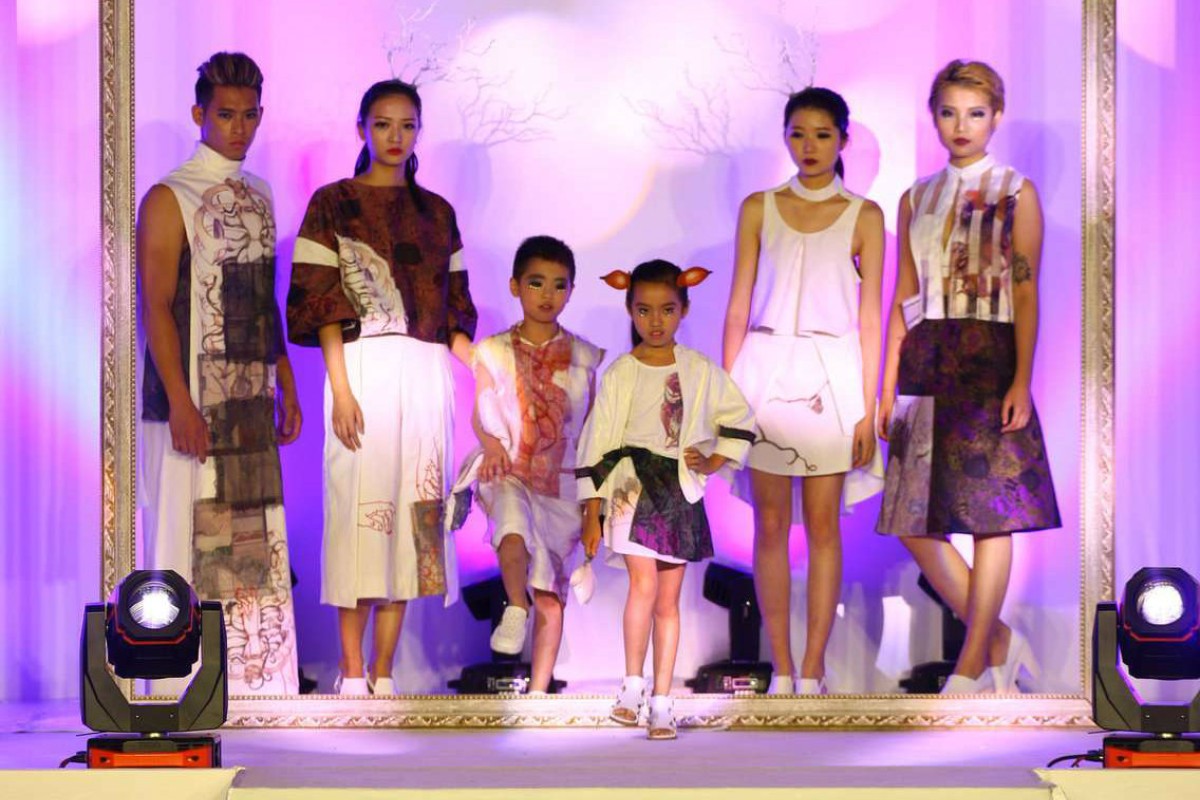
Students at Lam Tai Fai College are letting their clothes do the walking and talking at their annual fashion show
 Six pieces of menswear, womenswear and childrenswear designed by the students.
Six pieces of menswear, womenswear and childrenswear designed by the students. On a snazzy runway, the model flashes a grin at the crowd and takes off his goldfish-themed jacket to reveal perfect abs. The crowds squeal, then stop to admire the next piece, a women’s casual wear that has Chinese fisherfolk apparel features blended into its design.
With top-notch fashion pieces, elaborate 3D-printed head accessories and plenty of white lipstick, this grand spectacle has all the makings of a high-end fashion show, yet the creative minds behind the designs are local secondary students from Lam Tai Fai College.
Held every summer for the last 12 years, the school’s fashion show is one of its biggest events. Students spend up to six months designing and making their collection, which contains around six pieces of menswear, womenswear and childrenswear that expresses a particular concept.
This year, the theme is ‘Dream Painter’. Physical artwork by the students, who study fashion design as part of the school’s visual arts programme, are sent to factories and made into fabric prints.
“Often you find your ideas constrained by the type of fabric that is available on the market,” says fashion design teacher Camille Wang.
“When you don’t get the right fabric, you just can’t fully express your concept.” Because students get to print their own fabric, they can fully customise it to suit their unique designs. One group chose patterns from the Secret Garden colouring book. Another simply used a blue ballpoint pen to sketch abstract, Picasso-inspired self-portraits, which they printed onto a plain white fabric. “The ballpoint pen is a very common medium, used by students in school every day. But by sculpting the fabric into very 3D fashion pieces, they were able to achieve a Chinese blue-and-white porcelain effect, which was very impressive.”
The collection Blue Self-portrait, designed by Form Four students Chan Hiu-tung, Lee Yeuk-hei and Winnie Zhuang Zixin, beat 14 other teams to win the Overall Grand Prize.
Other students used the opportunity to express their political views. Symbiosis Sympathy, which won the Champion Prize, is a collection that reflects the harm of urban development on rural life. The pieces have drawings of bones intertwined with shrivelled vegetation. Patches of dark green squares are sewn on, representing aerial views of lost grasslands. A pair of watchful owls adorn the back of the main menswear piece.
“Urban development is important. Like in Hong Kong, people work hard day and night, but they forget that human relationships are important as well. If we don’t stop, we’ll just be money-making machines in a concrete jungle,” says Form Five student Cheung Yuen-wing, who went with her team to Ma Shi Po Village in Fanling to get inspiration for their project. The land there is owned by developer Henderson Land, which has been evicting occupants there as part of a redevelopment plan in the North Eastern New Territories. “Ten years ago when we were small, we got to play around in parks. Now, kids just play with phones and tablets.
What will the future look like? Would children even know the colours of a leaf? Would they have to find the answer on Google?” says Yuen-wing.
Her groupmate, Chan Ka-yan, says compared with other art medium, fashion is a great for expressing opinions – you can make a literal fashion statement. “An oil painting has to be displayed somewhere and people will have to go to see it. But for a piece of clothing, you can just wear it on the streets, and people would notice you right away,” says the Form Five student.
Patience is key to becoming a good fashion designer, says Wang, who worked as a tailor in a clothing factory before entering the industry. Before she teaches students technical skills, she guides them on ways to appreciate works by different designers. Then, students must come up with a concept of what they want to express. From there, they can select their colour palette and fabric type. After that, students have to decide on their practical goals, like for what occasion they would want their piece to be worn.
Wang says she notices that most students take research too lightly. “They think they can make anything that they imagine. But without proper research and experimentation, they end up neglecting a lot of details that are crucial to make the piece work out,” she says.
For students interested in becoming a fashion designer, Wang recommends starting with simple projects, such as making handbags, skirts, or clothes for your dolls and pets. There is no shortcut to success. “Watch a few episodes of [reality TV series] Project Runway and you’ll get a decent idea of what it’s like. Putting in a lot of effort doesn’t mean you’ll get guaranteed results,” she says. “There’s a big demand for fashion designers, but it’s a tough industry.”